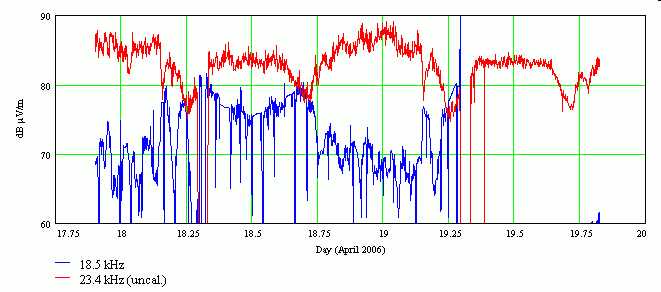The first plot (Fig.1) shows the fieldstrength since April 17th, 21:41 UT (plotted as day number 17.9). The tests on 18.5 kHz currently follow a repeating pattern of three different modulation types, with an unmodulated carrier, 50 bd GMSK and 50 bd FSK for one hour each, interrupted by occasional short breaks. When recording maximum bin levels from a narrowband FFT, the different spectral spread of the waveforms can be accounted for by correction factors (0 dB, 11 dB and 14 dB respectively for 1.47 Hz bins). Absolute levels have been calibrated for 18.5 kHz, using an SPM-3 level meter and the known loop area, but not for 23.4 kHz. Since day 19.25, I am using better averaging, which should result in smoother curves.

Fig.1: Fieldstrength of DHO38
On 23.4 kHz, there is a fairly flat daytime level (about 84 dBµV/m uncal.), surrounded by 5 dB dips at sunrise and sunset. During the night, there is a maximum, peaking about 4 dB above daytime level at midnight (18.0 and 19.0). However the situation is almost reversed on 18.5 kHz: The strongest levels (80 dBµV/m) occur around dawn and dusk, there is a shallow minimum at noon, and very low levels (more than 10 dB down) at night. The latter are accompanied by strong random fading, accompanied by pronounced variations in the apparent direction of arrival (see Fig. 2), which are very conspicuous in the colour-DF spectrograms.

Fig.2: Apparent direction of arrival
Fig.3 is a polar scatter plot of the same data set, showing fieldstrength versus azimuth (within the 180° unambiguous range of the two loops). The daytime points are gathered in narrow streaks close to the true azimuth, 30° west of north. At night, scattered clouds of points are produced, centered roughly on 18 and 2 mV/m for 23.4 and 18.5 kHz respectively.

Fig.3: Fieldstrength versus DOA
My assumption is that the different diurnal patterns at the two frequencies are caused by different relative phaseshifts between the groundwave and a varying skywave component. At my distance of 475 km and for a reflection height at 74 km, the ionospheric path would geometrically be about 25 km longer. Assuming no extra phaseshift from the reflection itself (consistent with refraction in a smoothly varying medium), we would expect to see the two components in phase at 24 kHz and out of phase at 18 kHz.
At night, we see a reflection from the E layer, with a strength similar to the groundwave, leading to an enhancement at 23.4 kHz and near-cancellation at 18.5 kHz. At dawn, an absorbing D layer appears, leaving only the groundwave. During the day, a weaker (and lower height ) reflection from the D-layer builds up, peaking at noon.
For me, being used to skywave having a more or less random phase at HF, the repeatable and predictable interference pattern on VLF was a little unexpected. Fig. 4 shows the relation between the minimum and maximum frequencies and the distance to the source, for a single-hop reflection at 74 km height. This could possibly applied to range finding for single-station lightning location.

Fig.4: Frequencies of skywave cancellation (blue) and enhancement (red)
- VLF colour-DF spectrograms
- DF6NM homepage